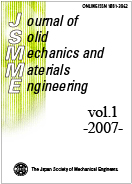Volume 1, Issue 8
Displaying 1-11 of 11 articles from this issue
- |<
- <
- 1
- >
- >|
Review
-
2007 Volume 1 Issue 8 Pages 947-974
Published: 2007
Released on J-STAGE: August 31, 2007
Download PDF (1330K)
Papers
-
2007 Volume 1 Issue 8 Pages 975-985
Published: 2007
Released on J-STAGE: August 31, 2007
Download PDF (623K) -
2007 Volume 1 Issue 8 Pages 986-997
Published: 2007
Released on J-STAGE: August 31, 2007
Download PDF (764K) -
2007 Volume 1 Issue 8 Pages 998-1004
Published: 2007
Released on J-STAGE: August 31, 2007
Download PDF (3066K) -
2007 Volume 1 Issue 8 Pages 1005-1016
Published: 2007
Released on J-STAGE: August 31, 2007
Download PDF (1302K) -
2007 Volume 1 Issue 8 Pages 1017-1025
Published: 2007
Released on J-STAGE: August 31, 2007
Download PDF (2075K) -
2007 Volume 1 Issue 8 Pages 1026-1034
Published: 2007
Released on J-STAGE: August 31, 2007
Download PDF (526K) -
2007 Volume 1 Issue 8 Pages 1035-1042
Published: 2007
Released on J-STAGE: August 31, 2007
Download PDF (1984K) -
2007 Volume 1 Issue 8 Pages 1043-1051
Published: 2007
Released on J-STAGE: August 31, 2007
Download PDF (2232K) -
2007 Volume 1 Issue 8 Pages 1052-1062
Published: 2007
Released on J-STAGE: August 31, 2007
Download PDF (1865K) -
2007 Volume 1 Issue 8 Pages 1063-1072
Published: 2007
Released on J-STAGE: August 31, 2007
Download PDF (425K)
- |<
- <
- 1
- >
- >|
